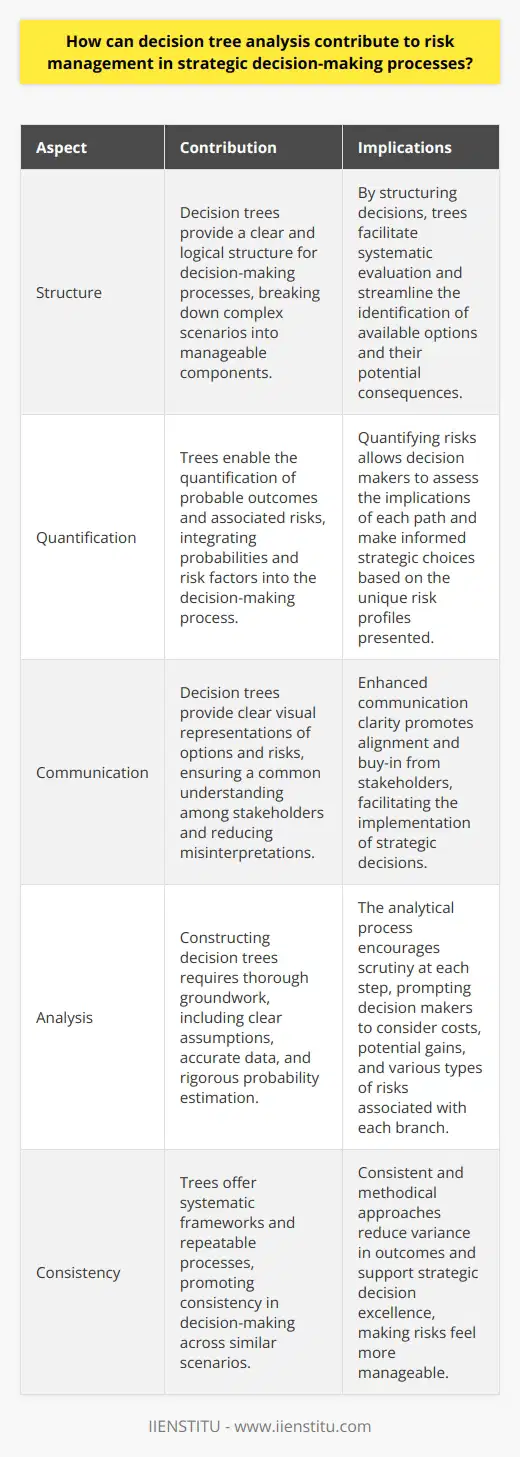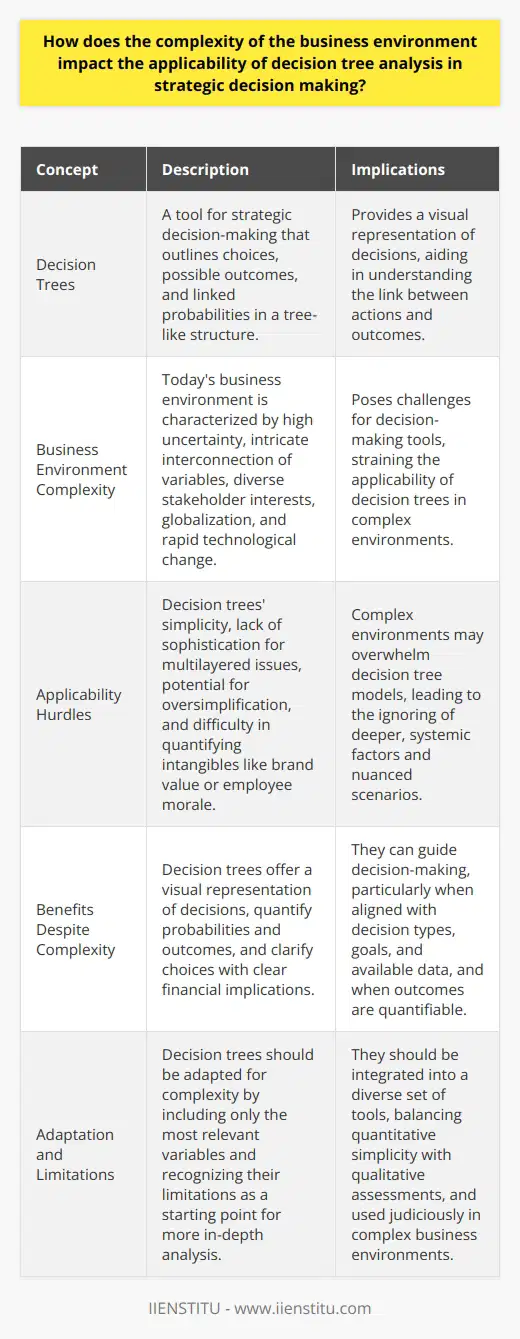
In an increasingly complex business environment, strategic decision making has become paramount for success. Among the many techniques employed by businesses, Decision Tree Analysis stands out for its clarity, ease of use, and efficiency in breaking down intricate decision processes into manageable parts.
In this article, we take a deep dive into the essence of Decision Tree Analysis, exploring its foundations, variations, and applications in the realm of business.
We'll also discuss how its implementation can be a game-changer for organizations looking to streamline their decision-making processes, providing an expert approach that is deeply user-oriented and enriched with practical examples.
Related articles:
Basics of Decision Tree Analysis
Definition of Decision Tree Analysis
Decision Tree Analysis is a graphical representation of decisions and their possible consequences, which are organized in a tree-like structure. It's a tool used to support the decision-making process by visualizing various alternatives and their potential outcomes in a clear and concise manner.
This method assists decision-makers in choosing the most favorable option by mapping out the different paths a decision could lead to, taking into account the risks, costs, and benefits associated with each branch.
Components of Decision Trees: Nodes, Branches, and Final Outcomes
Central to decision trees are nodes, branches, and final outcomes. Nodes represent points of decision, chance, or termination in a tree. Decisions nodes are depicted as squares, chance nodes as circles, and end nodes signify the conclusion of a path.
Branches extend from nodes and symbolize the choices available or the uncertain outcomes that could follow. At the end of these branches lie the final outcomes, which reflect the results of following a particular path, expressed in terms of payoff or another measure of success.
Brief history of Decision Tree Analysis
Decision Tree Analysis has its roots in operations research and management science. It was developed in the mid-20th century as a tool for organizational and business strategy, and has since been refined with computational advances.
Its application has grown broadly, not just in business but also in fields like medicine, engineering, and law, making it a versatile tool for any decision-making scenario that involves uncertain outcomes.
Types of Decision Trees
Classification Trees
Classification trees are a type of Decision Tree used primarily in machine learning and statistics to categorize instances into discrete groups based on input variables. They are particularly useful in assignments that require clear differentiation – such as when a finance company must decide whether to approve or deny a loan application based on applicant's attributes.
Regression Trees
Conversely, regression trees are applied when the target variable is numerical or continuous. These trees predict the value of a target based on the input variables. For example, a real estate company might use a regression tree to predict house prices based on features like size, location, and number of bedrooms.
Explanation and examples of each
Both types of trees divide the dataset into distinct strata by making sequential, hierarchical decisions regarding the input data. In a classification tree, an insurance company may classify customers into high and low risk categories while a regression tree could help a marketing firm predict how much a customer is willing to spend based on demographic data. Interpreting these trees involves understanding the series of conditions that lead to a particular classification or prediction.
Utilizing Decision Trees in Business
Decision Tree Analysis serves as a robust tool in business, providing a framework for clear and systematic consideration of complex decision-making situations.
The importance of Decision Trees stems from their ability to simplify the decision-making process by visualizing the options and potential outcomes, thus helping businesses to evaluate the probable impacts of various choices before committing to a course of action.
Real-world examples of Decision Tree Analysis employed in various business scenarios
One real-world example of Decision Tree Analysis is in prioritizing investment opportunities. A company might use a decision tree to decide between investing in a new product line, entering a new market, or upgrading its existing infrastructure. By mapping out the potential returns and risks associated with each option, the company can make a well-informed decision. In customer service, decision trees empower agents with a script or flowchart that dictates how to respond to various customer inquiries or problems, ensuring efficiency and consistency in service delivery.
Process of Creating a Decision Tree
Steps for constructing a Decision Tree
Developing a Decision Tree begins with identifying the primary decision to be made. Afterward, the subsequent choices, uncertainties, and outcomes are added sequentially. Each branch of the tree represents a possible decision or event, and each node on the branch represents the outcome of the previous step. This iterative process continues until all significant variables are included, and all final outcomes are represented.
Tips and considerations during the tree design phase
When designing a Decision Tree, one must be thorough yet economical with the level of detail. Over-complication can make the tree unwieldy and difficult to interpret, while oversimplifying may overlook key variables. Additionally, it is important to base the branches and outcomes on accurate, reliable data and consider the tree structure's feasibility for the specific context of the business scenario.
Highlight on post-pruning and pre-pruning during decision tree construction
Trees could grow very large with many branches, potentially leading to overfitting, where the tree models the training data too closely and performs poorly on unseen data. This is where post-pruning, a tactic to trim some of the tree's branches after full development, becomes pivotal. In contrast, pre-pruning involves setting conditions that prevent the tree from becoming overly complex as it's built. Both techniques aim to enhance the model's generalization to new, unseen data.
Practical example on building a decision tree
Consider a company that needs to determine whether to launch a new product. The decision tree's root node would be the decision to launch or not, with branches considering market conditions, competitors' actions, cost of production, and potential sales revenue. As the tree expands, the outcomes become more explicit, helping leaders evaluate the risks and benefits on granule levels. This enables the company to navigate through complex market data and forecast the launch's viability.
Interpreting a Decision Tree
Explanation of how to read and interpret a Decision Tree
To interpret a Decision Tree, one must start from the root node and follow the branches based on the specific conditions they entail. At each decision node, the choice that leads to the most favorable outcome is selected. Chance nodes account for the probability of certain events happening, affecting the pathway to be taken. The eventual goal is to reach a decision that optimizes desired outcomes, such as profit or cost savings.
Common misconceptions and difficulties in interpreting Decision Trees
Some misconceptions about Decision Trees include the belief that they can impeccably predict future events or that higher complexity in a tree implies better decision-making prowess. However, in practice, simpler trees are often more robust and easier to interpret. Interpreting a Decision Tree also requires consideration of the statistical significance of branches and nodes.
Real-life example to illustrate the interpretation process
Take, for example, a retail company deciding where to expand its physical stores. The decision tree may show that urban expansion maximizes potential foot traffic, but when factoring in higher real estate costs (a chance node), suburban areas might offer a better return on investment. In this scenario, interpreting the tree involves weighing these qualitative and quantitative factors to arrive at a strategic conclusion.
Limitations of Decision Tree Analysis
Overview of potential pitfalls or limitations of utilizing Decision Trees
Despite their usefulness, Decision Trees come with potential pitfalls; they can become overly complex, making the final decision harder to interpret, or they may not efficiently handle certain types of structured data. Additionally, Decision Trees can be biased towards branches with more levels and may not be the best tool for predicting events with high uncertainty.
Strategies to overcome these limitations and improve decision tree accuracy
To improve accuracy and mitigate the limitations, tree complexity can be managed through pruning techniques. Ensemble methods like Random Forests and Gradient Boosting can be used to better handle data variance and improve predictive accuracy. Furthermore, cross-validation techniques can help ensure the tree's reliability on unseen data.
Decision Tree Analysis is a powerful and versatile tool for strategic decision making, particularly in the context of business where data-driven choices can yield significant competitive advantages. From understanding the basics to interpreting complex models and recognizing limitations, mastery of this tool requires both the big picture and attention to detail.
Nonetheless, the benefits that can be reaped from effectively applying Decision Tree Analysis are considerable, making it an essential skill in the modern, data-rich business landscape.
By providing comprehensive knowledge of the process, coupled with hands-on experiences and an expert approach, this article seeks to embolden practitioners to further explore and apply Decision Tree Analysis. For those looking to delve deeper into this topic, engaging in a problem solving course free of charge or an online certificate course can be a valuable step towards achieving proficiency in this domain. As the need for strategic decision-making processes only grows, the ability to navigate and employ Decision Tree Analysis becomes ever more crucial.
Frequently Asked Questions
What are the fundamental principles underlying decision tree analysis in strategic decision making?
Decision Tree Analysis in Strategic Decision Making
Unpacking Decision Trees
Decision trees allow a visual mapping of options. They reflect a sequence of choices and outcomes. Each branch represents a potential decision or event. Trees grow complex with more branches. Strategists favor decision trees for this clarity.
Core Principles of Decision Trees
Sequential Decisions Drive the Process. Trees showcase options step by step. They unfold like a story. Each decision leads to distinct consequences. Choices at one node inform the next.
Probability Factors into Analysis. Nodes assign probabilities to outcomes. Higher probability indicates a likelier result. This quantification aids in comparing options.
Outcomes Have Attached Values. Each result carries a projected value. Values may represent profits, costs, or other metrics. This helps strategists assess potential benefits.
Branches Account for Uncertainty. Decision trees accept that not all is predictable. They map uncertainty through branches. Each branch is a different scenario.
The Time Value of Money is Integral. Future returns often mean less today. Trees account for this discounting. This ensures current decisions reflect future values accurately.
Utilizing Decision Trees Effectively
Identify All Relevant Choices and Outcomes. Full mapping requires thorough brainstorming. Overlooked options may skew the analysis. Comprehensive trees present a clear strategic picture.
Estimate Probabilities and Outcomes with Care. Robust analysis hinges on accurate data. Guesswork diminishes the tree’s utility. Solid data provides a trustworthy foundation.
Review and Challenge the Tree. Trees are not set in stone. Test the logic of each branch. Peer review improves the tree’s robustness.
Incorporate Trees within a Broader Analysis Framework. Decision trees are one tool. They join forces with other analytic methods. Combine tools for a more complete strategy.
Decision trees guide through strategic fog with clarity. They demand sequential thought and value accuracy. Their visual nature simplifies the complex. Yet, they are but one tool in the decision-maker's kit. Adaptation and broad perspective enrich their use.

How can decision tree analysis contribute to risk management in strategic decision-making processes?
Decision Tree Analysis in Risk Management
Understanding Decision Trees
Decision trees represent a core tool. They structure choices. They display outcomes. Trees capture decision logic. They focus on measurable results. They clarify complex scenarios. Decision trees aid risk assessment. They align with strategic decision-making.
The Role of Decision Trees in Strategic Planning
In strategic planning, risks abound. Decisions must address unknowns. Trees facilitate systematic evaluation. They present visual depictions. Options break down into branches. Consequences follow logically.
Choice identification becomes streamlined. Trees list potential strategies. Each node represents a decision. Each branch symbolizes an option. Decisions lead to different paths.
Assessing Probable Outcomes and Related Risks
Trees quantify probable outcomes. They integrate probabilities. Each outcome links to a likelihood. Risk factors become quantifiable. Each path carries risk levels. Tree analysis weighs these risks.
Multi-faceted scenarios complicate strategies. Trees simplify these situations. They compare varied paths. Each shows unique risk profiles. Decision makers grasp implications.
Facilitating Clear Communication
Communication clarity is crucial. Decision trees provide clear visuals. Stakeholders see options and risks. They understand strategic decisions better. Trees ensure common understanding. Misinterpretations reduce.
Encouraging Thorough Analysis
Trees require thorough groundwork. Assumptions must be clear. Data needs accuracy. Probabilities demand rigorous estimation. Each step in a tree invites scrutiny. Reality checks become mandatory.
Each branch prompts questions. What are the costs? What gains can follow? Risks must be identified. Considerations include financial, operational, and reputational risks. Trees ensure each receives attention.
Supporting Consistent Decision-Making
Consistency in decisions is key. Trees offer systematic frameworks. They provide repeatable processes. Decisions across similar scenarios align. Variance in outcomes diminishes. Trees encourage methodical approaches.
Decision tree analysis stands out. It offers clarity and methodology. It enables nuanced risk valuation. Strategic choices become informed. Risks no longer feel insurmountable. Decision trees turn risks manageable. They support strategic decision excellence.

How does the complexity of the business environment impact the applicability of decision tree analysis in strategic decision making?
The Role of Decision Trees in Complex Business Environments
Understanding Decision Trees
Decision trees represent a tool for strategic decision-making. They outline choices, possible outcomes, and linked probabilities. They assume a tree-like structure. From each decision node, branches emerge. These branches denote potential paths. They reflect different courses of action. Each path has probabilities and outcomes.
Complexity in Business
The business environment today bears complexity. It poses challenges for decision-making tools. Uncertainty runs high. Variables interconnect intricately. Stakeholders bring diverse interests. Globalization adds layers of considerations. Technology accelerates change.
Applicability Hurdles
Complex environments strain decision trees' applicability. Simplicity is a core strength of decision trees. They lack sophistication for multilayered issues. Multiple variables can overwhelm the model. This may lead to oversimplification. Nuanced scenarios escape clear-cut categorization. Decision trees may ignore deeper, systemic factors. Intangibles like brand value or employee morale are hard to quantify.
Benefits Despite Complexity
Nevertheless, decision trees offer clear benefits. They provide a visual representation of decisions. This aids in understanding the link between actions and outcomes. They quantify probabilities and outcomes. That allows for some measure of objective comparison. They can clarify choices with clear financial implications.
Decision Trees Enhance Strategic Decision-Making
In strategic decision-making, context dictates tools. Decision trees align with decision types, goals, and available data. They function best with clear, discrete options. They serve well when probabilities are available. They thrive when outcomes are quantifiable.
Decision Trees as a Guide, Not a Panacea
Decision trees can guide but not dictate in complex environments. They work as part of a broader decision-making arsenal. They require complementation by other analytical methods. Qualitative assessments must balance the quantitative simplicity.
Adaptation and Limitations
Recognize and address decision trees' limitations. Adapt them for complexity. Include the most relevant variables only. Accept that decision trees are a starting point. They prompt more in-depth analysis where needed. They refine thinking but don't replace it.
Complex business environments present a test for decision trees. They limit but do not eliminate their usefulness. Decision-makers must deploy decision trees judiciously. They should integrate them into a diverse set of tools. Decision trees can simplify the beginnings of analysis. They cannot encapsulate the entirety of complex strategic decisions. Use them wisely. Recognize their value and boundaries.



